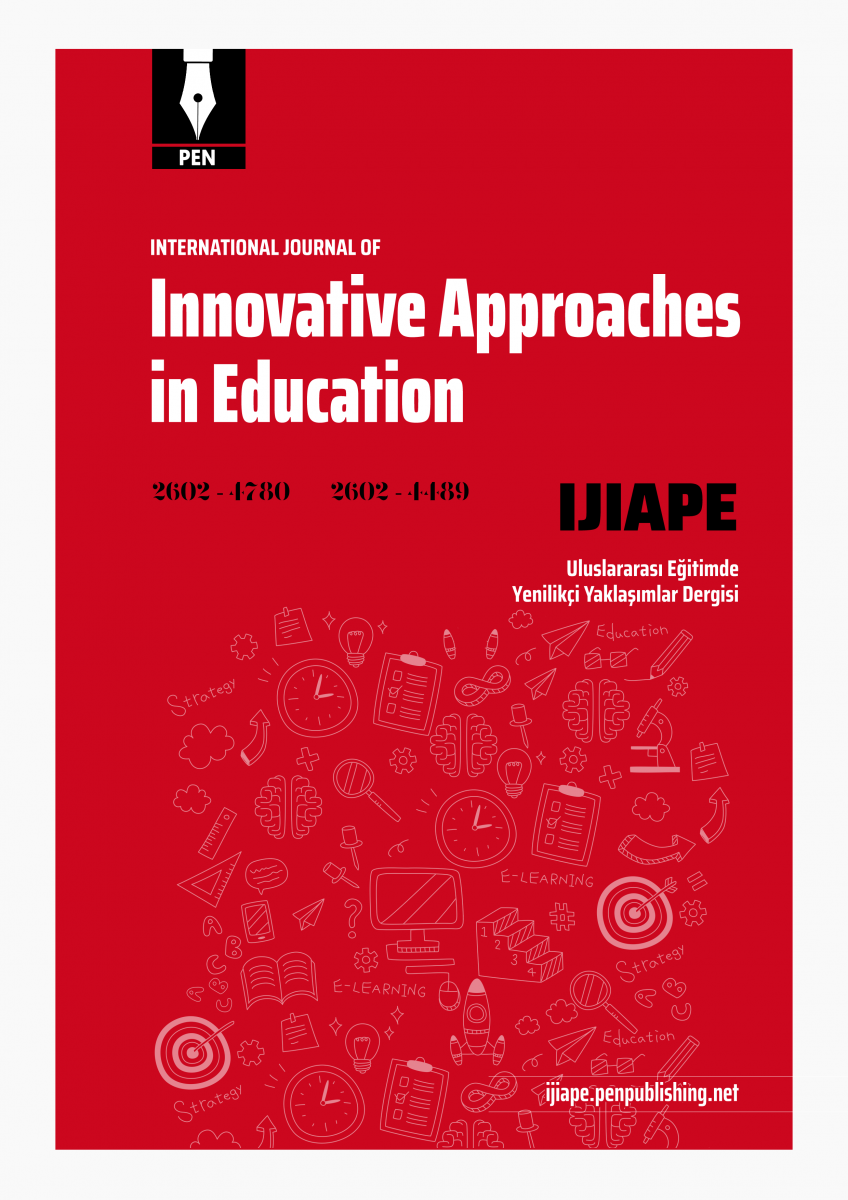- Abbitt, J. T. (2011). An investigation of the relationship between self-efficacy beliefs about technology integration and technological pedagogical content knowledge (TPACK) among preservice teachers. Journal of digital learning in teacher education, 27(4), 134-143. [Google Scholar]
- Anna, W. (2019). Cyberbullying in the light of challenges of school-based prevention. International Journal of Cognitive Research in Science, Engineering and Education, 7(3), 13-26. [Google Scholar]
- Ayas, T., & HORZUM, M. B. (2011). Exploring the Teachers' Cyber Bullying Perception in terms of Various Variables. International Online Journal of Educational Sciences, 3(2). [Google Scholar]
- Baki, A., & Gökçek, T. (2012). An overview of mixed methods research. Electronic Journal of Social Sciences, 11(42). [Google Scholar]
- Bandura, A., & Freeman, W. H. (1997). Company. Self-Efficacy: The Exercise of Control. [Google Scholar]
- Bandura, A. (2001). Social cognitive theory: An agentic perspective. Annual review of psychology, 52(1), 1-26. [Google Scholar]
- Bandura, A., Freeman, W. H., & Lightsey, R. (1999). Self-efficacy: The exercise of control. [Google Scholar]
- Büyüköztürk, Ş., Kılıç-Çakmak, E., Akgün, Ö., Karadeniz, Ş., & Demirel, F. (2008). Bilimsel araştırma yöntemleri. [Google Scholar]
- Chowdhury, M. (2020), “4 ways to improve and increase self-efficacy”, available at: https://positivepsychology.com/3-ways-build-self-efficacy/. [Google Scholar]
- Early Intervention Foundation (EIF). (2021, October). The Teacher Tapp survey, commissioned by the EIF, took place in October 2021 with 4,336 secondary school teachers. Retrieved from https://www.eif.org.uk/press-release/only-one-in-three-teachers-feel-equipped-to-help-stop-cyberbullying [Google Scholar]
- Eden, S., Heiman, T., & Olenik‐Shemesh, D. (2013). Teachers’ perceptions, beliefs and concerns about cyberbullying. British journal of educational technology, 44(6), 1036-1052. [Google Scholar]
- Firat, M., Yurdakul, I. K., & Ersoy, A. (2014). Bir eğitim teknolojisi araştırmasına dayalı olarak karma yöntem araştırması deneyimi. Eğitimde Nitel Araştırmalar Dergisi, 2(1), 64-85. [Google Scholar]
- Fredrick, S. S., Coyle, S., & King, J. A. (2023). Middle and high school teachers' perceptions of cyberbullying prevention and digital citizenship. Psychology in the Schools, 60(6), 1958-1978. [Google Scholar]
- Gürpınar, A., & Oğuz, E. (2018). Examination of the relationship between teachers’ cyberbullying awareness and online technologies self-efficacy (istanbul silivri sample). [Google Scholar]
- Hayashibara, K. N. E. (2017). Teachers' perceptions of cyberbullying (Doctoral dissertation, University of Southern California). [Google Scholar]
- Holden, H., & Rada, R. (2011). Understanding the influence of perceived usability and technology self-efficacy on teachers’ technology acceptance. Journal of Research on Technology in Education, 43(4), 343-367. [Google Scholar]
- Honicke, T., & Broadbent, J. (2016). The influence of academic self-efficacy on academic performance: A systematic review. Educational research review, 17, 63-84. [Google Scholar]
- Horzum, B. M., & Çakır, Ö. (2009). Çevrim içi teknolojilere yönelik öz yeterlik algısı ölçeği Türkçe formunun geçerlik ve güvenirlik çalışması. International Society for Technology in Education (ISTE). (2021). ISTE standards for educators: Empowered Professional. https://www.iste.org/standards/iste-standards-for-teachers [Google Scholar]
- Horzum, M. B. ve Ayas, T. (2013). Rehber öğretmenlerin sanal zorbalık fakındalık düzeyinin çeşitli değişkenlere göre incelenmesi. Hacettepe Üniversitesi Eğitim Fakültesi Dergisi (H. U. Journal of Education), 28(3), 195-205. [Google Scholar]
- Karas K. (2019). Internet self-efficacy and attitudes toward cyberbullying prevention programs in teachers and mental health professionals in Minnesota. (Published Ph.D. thesis, ProQuest Number: 27548514), Capella University, US. [Google Scholar]
- Koh, J. H., & Frick, T. W. (2009). Instructor and student classroom interactions during technology skills instruction for facilitating preservice teachers' computer self-efficacy. Journal of Educational Computing Research, 40(2), 211-228. [Google Scholar]
- Kundu, A. (2020). Toward a framework for strengthening participants' self-efficacy in online education. Asian Association of Open Universities Journal, 15(3), 351-370. [Google Scholar]
- Lareki, A., Altuna, J., & Martínez-de-Morentin, J. I. (2023). Fake digital identity and cyberbullying. Media, Culture & Society, 45(2), 338-353. [Google Scholar]
- Locke, E. A. (1997). Self-efficacy: The exercise of control. Personnel psychology, 50(3), 801. [Google Scholar]
- Macaulay, P. J., Betts, L. R., Stiller, J., & Kellezi, B. (2018). Perceptions and responses towards cyberbullying: A systematic review of teachers in the education system. Aggression and violent behavior, 43, 1-12. [Google Scholar]
- Marvasti, A.B. (2004). Qualitative Research in Sociology. Thousand Oaks, London, New Delhi: Sage. [Google Scholar]
- Miles, M. B.,& Huberman, A. M. (1994). Qualitative data analysis: An expanded sourcebook. Thousand Oaks, CA: Sage. [Google Scholar]
- Mliless, M., & Larouz, M. (2015, November). Students’ Safety of Private Information on Social Media Risks of Dissemination and Educational implications. In Conference Proceedings. Innovation in Language Learning 2015. [Google Scholar]
- Olenik-Shemesh, D., Heiman, T., & Eden, S. (2012) Cyberbullying victimization in adolescence: relationships with loneliness and depressive mood, Emotional and Behavioural Difficulties, 17:3-4, 361-374, https://doi.org/10.1080/13632752.2012.70422 [Google Scholar] [Crossref]
- Peng, R., Razak, R. A., & Halili, S. H. (2023). Investigating the factors affecting ICT integration of in-service teachers in Henan Province, China: structural equation modeling. Humanities and Social Sciences Communications, 10(1), 1-11. [Google Scholar]
- Prensky, M. (2012). From digital natives to digital wisdom. Thousand Oaks: CA: Corwin. [Google Scholar]
- Rajbhandari, J., & Rana, K. (2023). Cyberbullying on social media: An analysis of teachers’ unheard voices and coping strategies in Nepal. International journal of bullying prevention, 5(2), 95-107. [Google Scholar]
- Redmond, P., Lock, J. V., & Smart, V. (2018). Pre-service teachers' perspectives of cyberbullying. Computers & Education, 119, 1-13. [Google Scholar]
- Redmond, P., Lock, J. V., & Smart, V. (2020). Developing a cyberbullying conceptual framework for educators. Technology in Society, 60, 101223. [Google Scholar]
- Serin, H. (2012). Ergenlerde sanal zorbalık / sanal mağduriyet yaşantıları ve bu davranışlara ilişkin öğretmen ve eğitim yöneticilerinin görüşleri (Yayımlanmamış Doktora Tezi). İstanbul Üniversitesi, Sosyal Bilimler Enstitüsü, İstanbul, Türkiye. [Google Scholar]
- Tekindal, M., & Şerife, U. Ğ. U. Z. (2020). Nitel araştırma yöntemi olarak fenomenolojik yaklaşımın kapsamı ve sürecine yönelik bir derleme. Ufkun Ötesi Bilim Dergisi, 20(1), 153-172. [Google Scholar]
- Von Marées, N., & Petermann, F. (2012). Cyberbullying: An increasing challenge for schools. School psychology international, 33(5), 467-476. [Google Scholar]
- Woolfolk, A., & Margetts, K. (2012). Educational psychology Australian edition. Pearson Higher Education AU. [Google Scholar]
- Yenilmez, Y. ve Seferoğlu, S. S. (2013). Sanal zorbalık ve öğretmenlerin farkındalık durumlarına bir bakış. Eğitim ve Bilim, 38(169), 420-432. [Google Scholar]
|

